child restraint CHEVROLET CAVALIER 1998 3.G Owners Manual
[x] Cancel search | Manufacturer: CHEVROLET, Model Year: 1998, Model line: CAVALIER, Model: CHEVROLET CAVALIER 1998 3.GPages: 400, PDF Size: 20.74 MB
Page 19 of 400
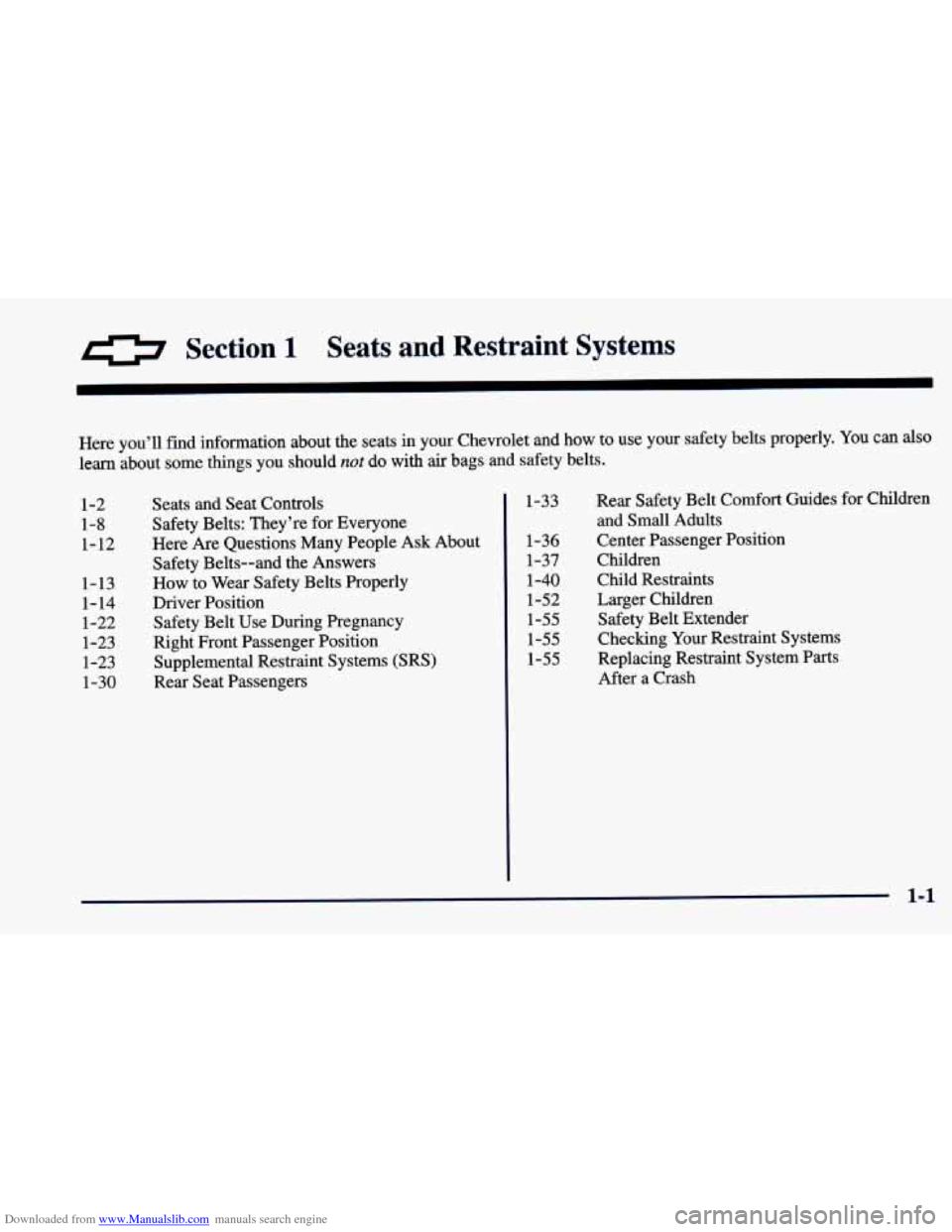
Downloaded from www.Manualslib.com manuals search engine 0 s ction 1 Seats and Restraint Systems
Here you’ll find information about the seats in your Chewolet and how to use your safety belts properly. You can also
learn about some things you should not do with air bags and safety belts.
1-2
1-8 1-12
1-13 1- 14
1-22 1-23
1-23 1-30 Seats
and Seat Controls
Safety Belts: They’re for Everyone
Here Are Questions Many People Ask About
Safety Belts--and the Answers
How to Wear Safety Belts Properly
Driver Position Safety Belt Use During Pregnancy
Right Front Passenger Position
Supplemental Restraint Systems (SRS)
Rear Seat Passengers 1-33
1-36
1-37 1-40
1-52 1-55
1-55
1-55 Rear
Safety Belt Comfort Guides
for Children
and Small Adults
Center Passenger Position
Children
Child Restraints
Larger Children Safety Belt Extender
Checking
Your Restraint Systems
Replacing Restraint System Parts
After a Crash
1-1
Page 31 of 400
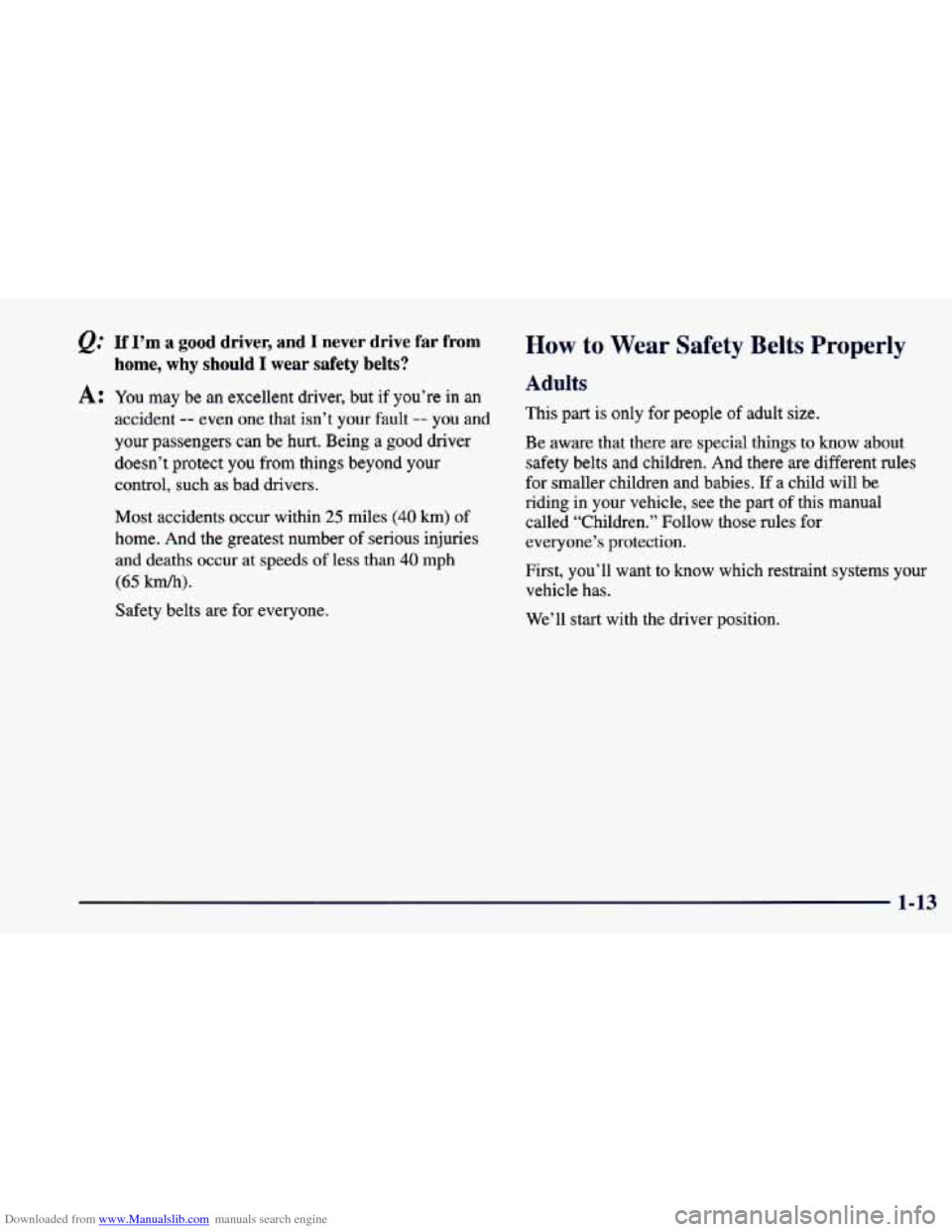
Downloaded from www.Manualslib.com manuals search engine Q.’ If I’m a good driver, and I never drive far from
home, why should I wear safety belts?
A: You may be an excellent driver, but if you’re in an
accident -- even one that isn’t your fault -- you and
your passengers can be
hurt. Being a good driver
doesn’t protect you from things beyond your
control, such as bad drivers.
Most accidents occur within
25 miles (40 km) of
home. And the greatest number
of serious injuries
and deaths occur at speeds
of less than 40 mph
(65 km/h).
Safety belts are for everyone.
How to Wear Safety Belts Properly
Adults
This part is only for people of adult size.
Be aware that there are special things to know about
safety belts and children. And there
are different rules
for smaller children and babies. If a child will be
riding in your vehicle, see the
part of this manual
called “Children.” Follow those rules for
everyone’s protection.
First, you’ll want to know which restraint systems your
vehicle has.
We’ll start with the driver position.
1-13
Page 42 of 400
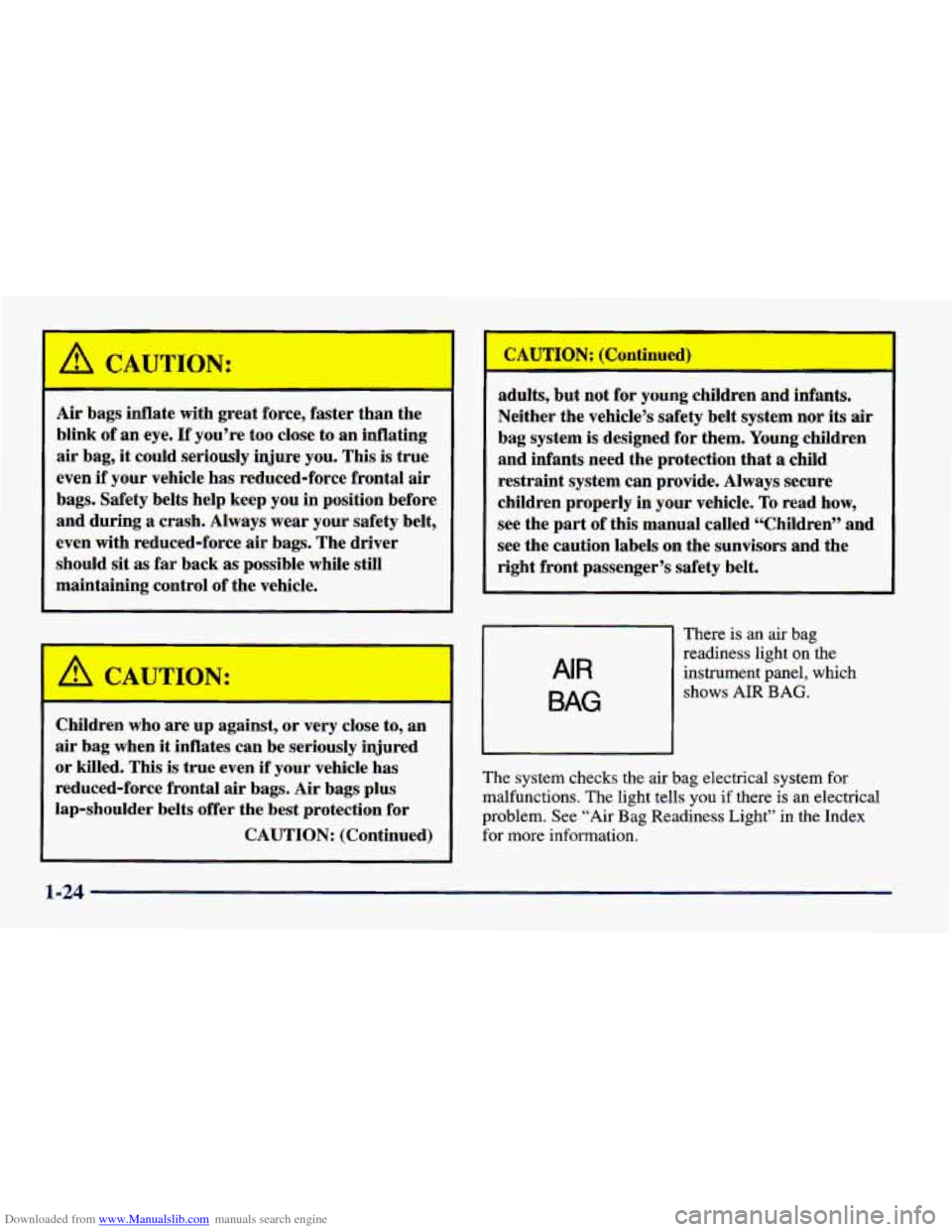
Downloaded from www.Manualslib.com manuals search engine I
Air bags inflate with great force, faster than the
blink of an eye.
If you’re too close to an inflating
air bag,
it could seriously injure you. This is true
even
if your vehicle has reduced-force frontal air
bags. Safety belts help keep you in position before
and during a crash. Always wear your safety belt,
even with reduced-force air bags. The driver
should sit
as far back as possible while still
maintaining control of the vehicle.
Children who are up against, or very close to, an
air bag when it inflates can be seriously injured
or killed. This is true even if your vehicle has
reduced-force frontal
air bags. Air bags plus
lap-shoulder belts offer the best protection for
CAUTION: (Continued) adults,
but not
for young children and infants.
Neither the vehicle’s safety belt system nor its
air
bag system is designed for them. Young children
and infants need the protection that
a child
restraint system can provide. Always secure
children properly in your vehicle.
To read how,
see the part of this manual called “Children” and
see the caution labels on the sunvisors and the
right front passenger’s safety belt.
There is an air bag
readiness light
on the
instrument panel, which
shows AIR BAG.
AIR
BAG
The system checks the air bag electrical system for
malfunctions. The light tells you if there is an electrical
problem. See “Air Bag Readiness Light” in the Index
for more information.
1-24
Page 51 of 400
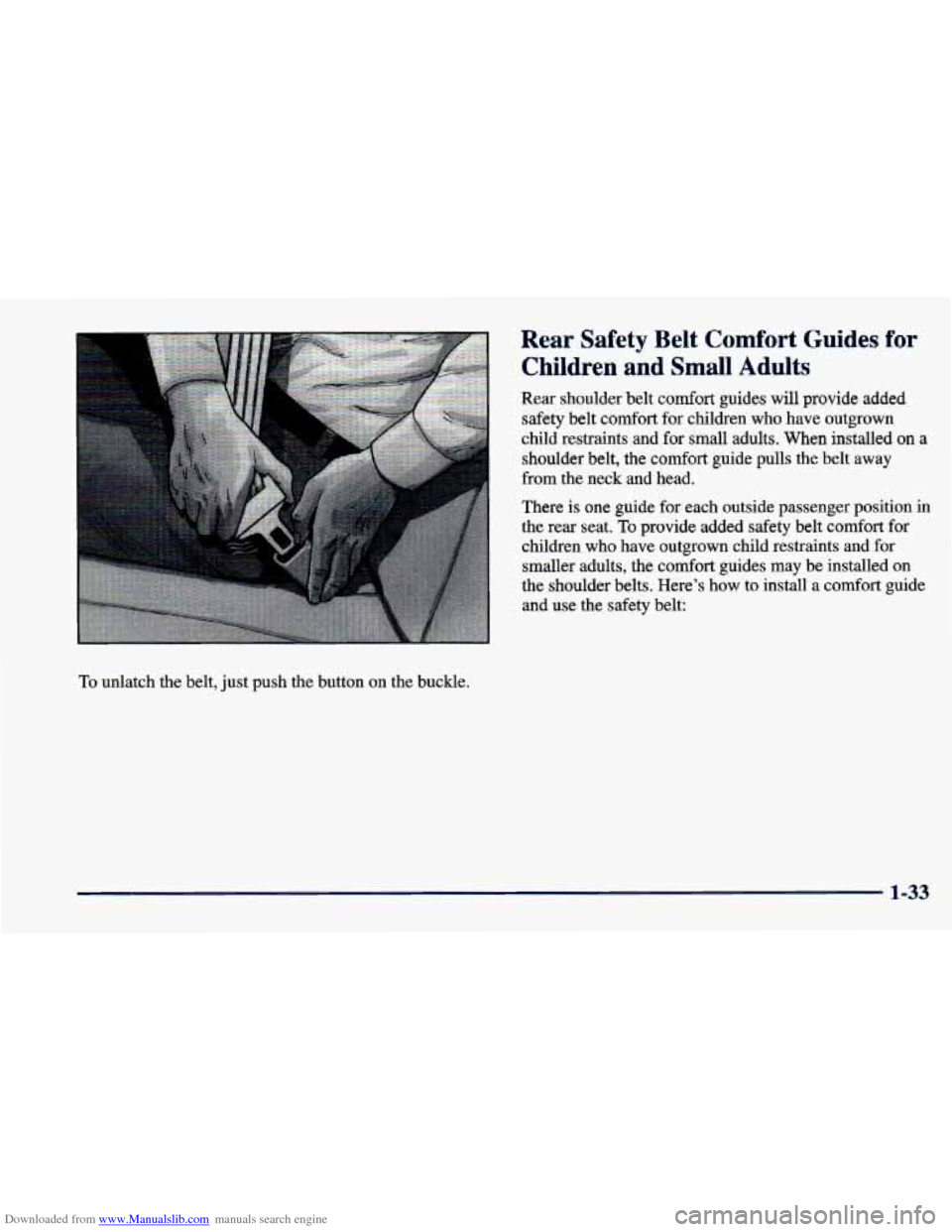
Downloaded from www.Manualslib.com manuals search engine To unlatch the belt, just push the button on the buckle.
Rear Safety Belt Comfort Guides for
Children and Small Adults
Rear shoulder belt comfort guides will provide added
safety belt comfort for children who have outgrown
child restraints and
for small adults. When installed on a
shoulder belt, the comfort guide pulls the belt away
from the neck and head.
There is one guide for each outside passenger position in
the rear seat.
To provide added safety belt comfort for
children who have outgrown child restraints
and for
smaller adults, the
comfort guides may be installed on
the shoulder belts. Here’s how to install
a comfort guide
and use the safety belt:
1-33
Page 55 of 400
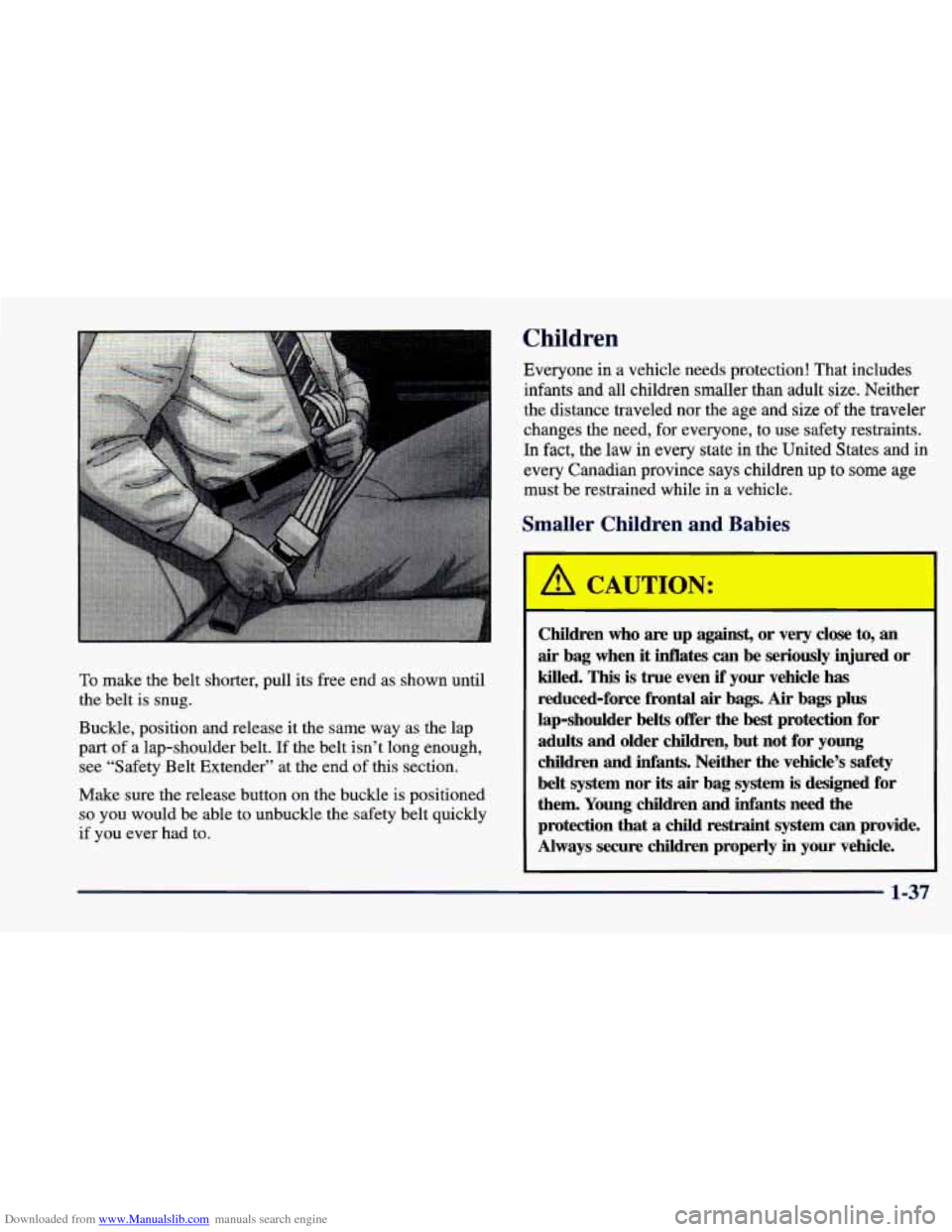
Downloaded from www.Manualslib.com manuals search engine Children
To make the belt shorter, pull its free end as shown until
the belt is snug.
Buckle, position and release it the same way as the lap
part of a lap-shoulder belt. If the belt isn’t long enough,
see “Safety Belt Extender” at the end of this section.
Make sure the release button on the buckle is positioned
so you would be able to unbuckle the safety belt quickly
if you ever had to. Everyone in
a vehicle needs protection! That includes
infants and all children smaller than adult size. Neither
the distance traveled nor the age and size
of the traveler
changes the need, for everyone, to use safety restraints.
In fact, the law in
every state in the United States and in
every Canadian province says children
up to some age
must be restrained while in
a vehicle.
Smaller Children and Babies
Children who are up against, or very close to, an
air bag when it inflates can be seriously injured or
killed. This is true even if your vehicle has
reduced-force frontal air bags. Air bags plus
lap-shoulder belts offer the best protection for
adults and older children, but not for young
children and infants. Neither the vehicle’s safety
belt system nor
its air bag system is designed for
them. Young children and
infants need the
protection that a child restraint system
can provide.
Always secure children properly
in your vehicle.
1-37
Page 56 of 400
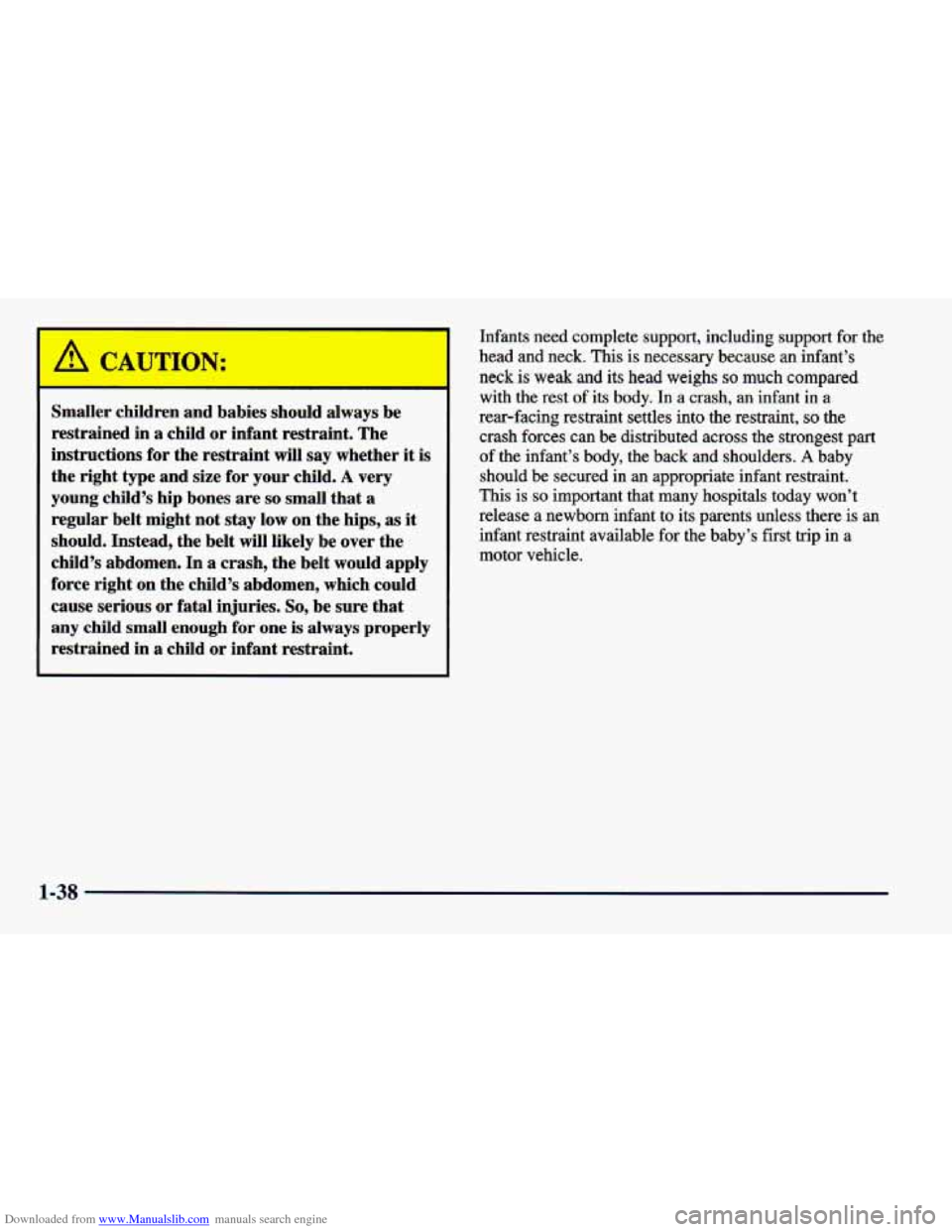
Downloaded from www.Manualslib.com manuals search engine Smaller child1 --A and babies should always be
restrained in a child or infant restraint. The
instructions for the restraint will say whether it is
the right type and size for your child.
A very
young child’s hip bones are
so small that a
regular belt might not stay low
on the hips, as it
should. Instead, the belt will likely be over the
child’s abdomen.
In a crash, the belt would apply
force right on the child’s abdomen, which could cause serious or fatal injuries.
So, be sure that
any child small enough for one
is always properly
restrained in a child
or infant restraint.
Infants need complete support, including support for the
head and neck. This is necessary because an infant’s
neck is weak and its head weighs so much compared
with the rest of its body. In a crash, an infant
in a
rear-facing restraint settles into the restraint, so the
crash forces can be distributed across the strongest
part
of the infant’s body, the back and shoulders. A baby
should be secured in
an appropriate infant restraint.
This is
so important that many hospitals today won’t
release a newborn infant to its parents unless there is an
infant restraint available for the baby’s first trip in a motor vehicle.
1-38
Page 58 of 400
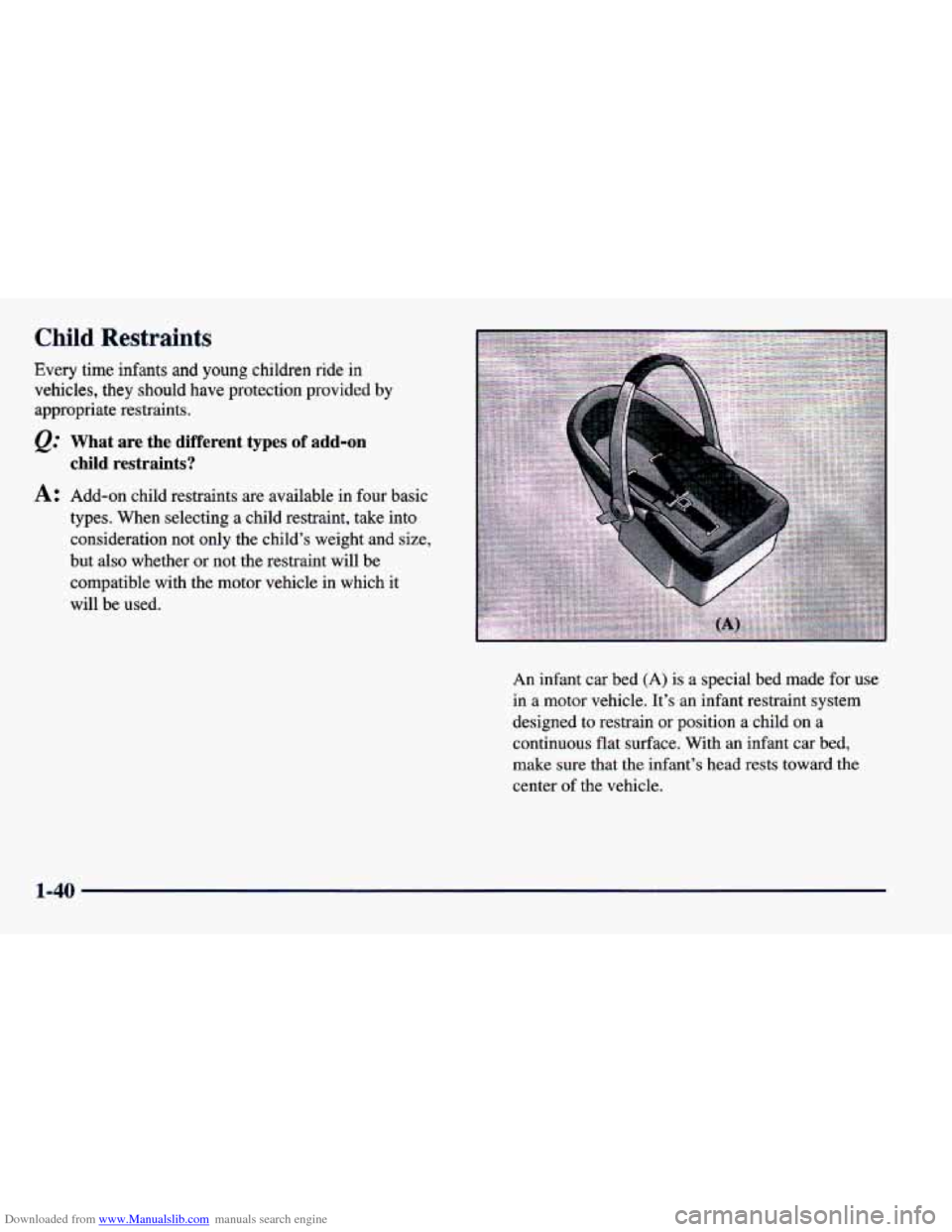
Downloaded from www.Manualslib.com manuals search engine Child Restraints
Every time infants and young children ride in
vehicles, they should have protection provided by
appropriate restraints.
@ What are the different types of add-on
child restraints?
A: Add-on child restraints are available in four basic
types. When selecting a child restraint, take into
consideration not only the child’s weight
and size,
but also whether or not the restraint will be
compatible with the motor vehicle in which it
will be used.
An infant car bed (A) is a special bed made
for use
in a motor vehicle. It’s an infant restraint system
designed to restrain
or position a child on a
continuous flat surface. With an infant car bed,
make sure that
the infant’s head rests toward the
center of the vehicle.
1-40
Page 60 of 400
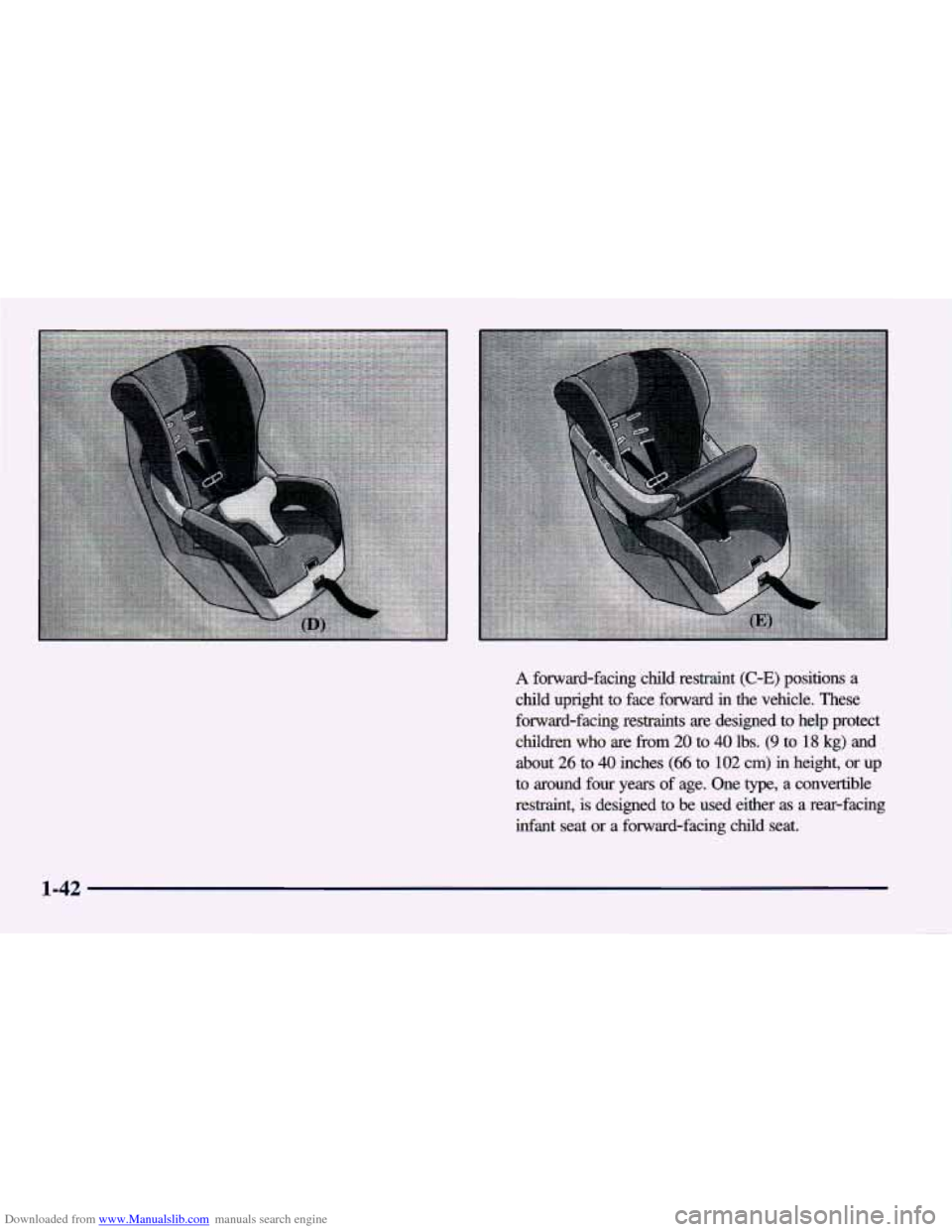
Downloaded from www.Manualslib.com manuals search engine A forward-facing child restraint (C-E) positions a
child upright to face forward in the vehicle. These
forward-facing restraints are designed to help protect
children who are fiom 20 to
40 lbs. (9 to 18 kg) and
about 26 to
40 inches (66 to 102 cm) in height, or up
to around four years of age. One type,
a convertible
restraint,
is designed to be used either as a rear-facing
infant seat or a forward-facing child seat.
1-42
Page 62 of 400
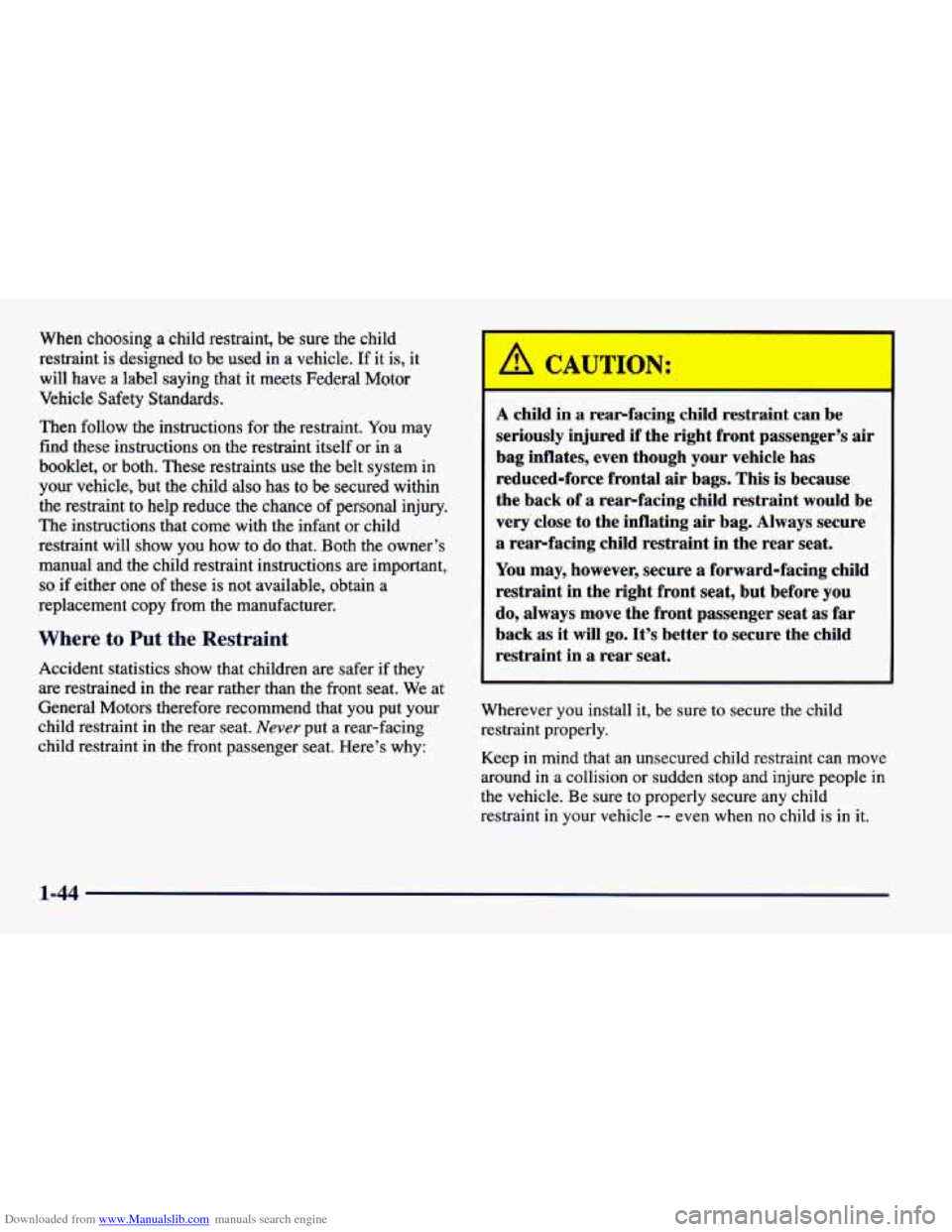
Downloaded from www.Manualslib.com manuals search engine When choosing a child restraint, be sure the child
restraint is designed to be used in a vehicle.
If it is, it
will
have a label saying that it meets Federal Motor
Vehicle Safety Standards.
Then follow the instructions for the restraint. You may
find these instructions on the restraint itself or in a
booklet, or both. These restraints
use the belt system in
your vehicle, but the child also has to be secured within
the restraint to help reduce the chance
of personal injury.
The instructions that come with the infant or child
restraint will show you how to
do that. Both the owner’s
manual and the child restraint instructions are important,
so if either one of these is not available, obtain a
replacement copy from the manufacturer.
Where to Put the Restraint
Accident statistics show that children are safer if they
are restrained in the rear rather than the front seat. We at
General Motors therefore recommend that you put your
child restraint in the rear seat.
Never put a rear-facing
child restraint in the front passenger seat. Here’s why:
A child in a rearfacing child rL,,raint can be
seriously injured if the right front passenger’s air
bag inflates, even though your vehicle has
reduced-force frontal air bags. This is because
the back of
a rearfacing child restraint would be
very close to the inflating air bag. Always secure
a rearfacing child restraint in the rear seat.
You may, however, secure a forward-facing child
restraint in the right front
seat, but before you
do, always move the front passenger seat
as far
back as it will go. It’s better to secure the child
restraint in
a rear seat.
Wherever you install it, be sure to secure the child
restraint properly.
Keep in mind that an unsecured child restraint can move
around in a collision or sudden stop and injure people in
the vehicle. Be sure to properly secure any child
restraint
in your vehicle -- even when no child is in it.
1-44
Page 63 of 400
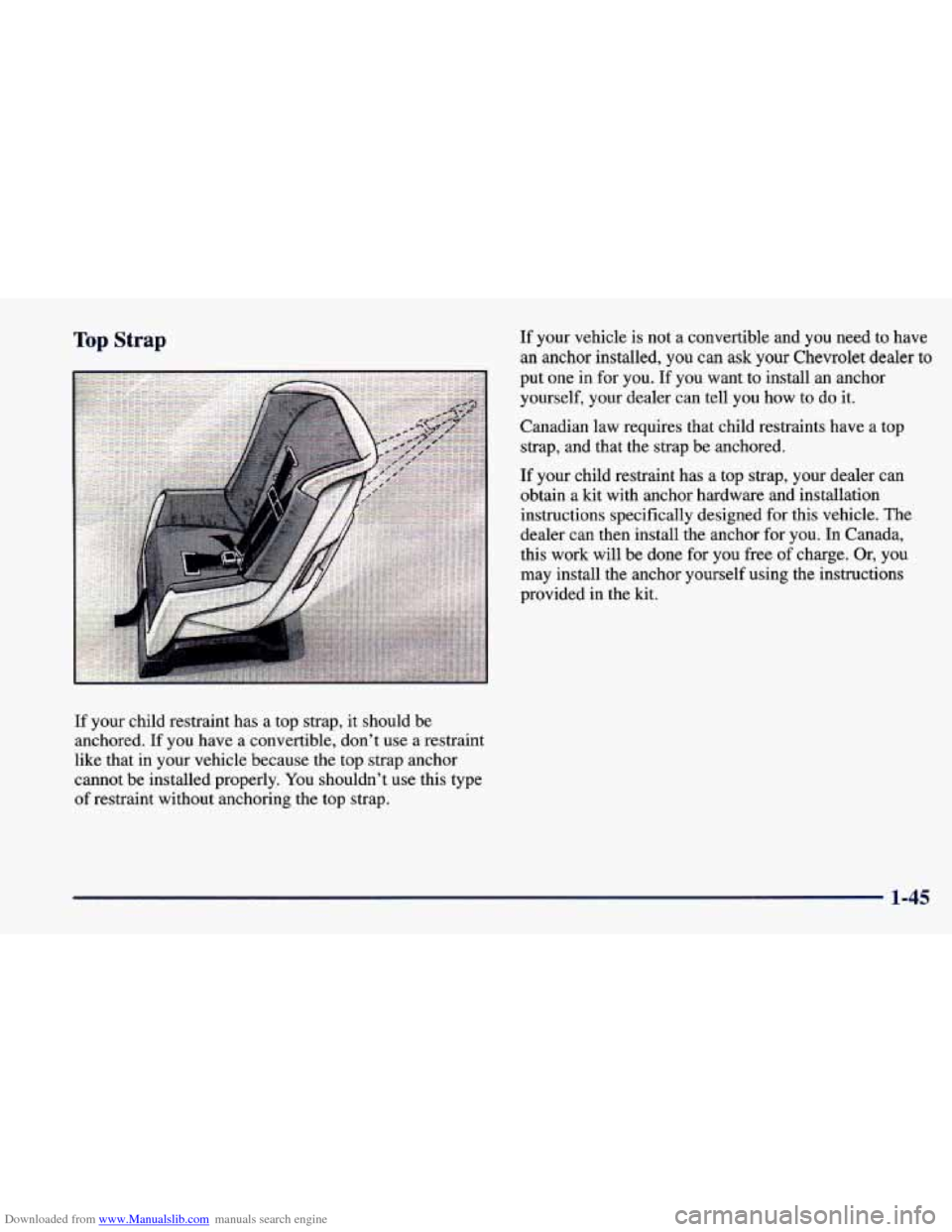
Downloaded from www.Manualslib.com manuals search engine Top Strap
If your child restraint has a top strap, it should be
anchored. If you have a convertible, don’t use a restraint
like that in your vehicle because the top strap anchor
cannot be installed properly. You shouldn’t use this type
of restraint without anchoring the top strap.
If your vehicle is not a convertible and you need to have
an anchor installed, you can ask your Chevrolet dealer to
put one in for you. If you want to install an anchor
yourself, your dealer can tell you how
to do it.
Canadian law requires that child restraints have a top
strap, and that the strap be anchored.
If your child restraint has a top strap, your dealer can
obtain a kit with anchor hardware and installation
instructions specifically designed for this vehicle. The
dealer can then install the anchor for you. In Canada,
this work will be done for you free of charge.
Or, you
may install the anchor yourself using the instructions
provided in the kit.
1-45